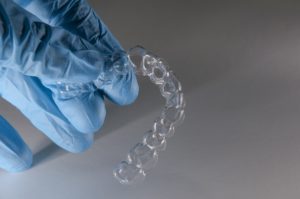 If you’re ready to invest in a straight smile, Invisalign is the clear choice in orthodontics. You don’t have to worry about any brackets or wires because aligners are fabricated to fit over your teeth. Advanced technology ensures they move your teeth in increments through continual pressure. It can be alarming if your aligners don’t fit as you had expected. You may not need new aligners. Here are a few tips to try before calling your dentist.
If you’re ready to invest in a straight smile, Invisalign is the clear choice in orthodontics. You don’t have to worry about any brackets or wires because aligners are fabricated to fit over your teeth. Advanced technology ensures they move your teeth in increments through continual pressure. It can be alarming if your aligners don’t fit as you had expected. You may not need new aligners. Here are a few tips to try before calling your dentist.
Invisalign Should Feel Tight
It can take time to adjust to wearing your aligners, so it can be difficult to know what to expect. It’s normal for them to feel tight, especially when beginning your treatment or switching to a new set. Although they might cause slight tenderness, it’s a sign your treatment is working.
You may notice small spaces with certain teeth, it’s not a reason for concern. It is space for the tooth to be moved to correct your bite and alignment. As your teeth move, the spaces will fill in.
Solutions for Poor-Fitting Aligners
If your aligners aren’t fitting correctly, the solution may be simple. It can take some practice putting your aligners in properly, but here are a few tips to make the transition easier:
Use “Chewies”
If you’ve just begun your journey with Invisalign, or you’ve switched to a new set of aligners, it can be difficult to get them over your teeth. Invisalign “Chewies” can help get your aligners into position easier. They are shaped like a cotton ball and made of soft material. Chewing on them for 3-5 minutes will get your aligners in place. They will be forced over your teeth to resolve any gaps.
Wear Your Aligners Long Enough
Poor-fitting aligners are a common problem if you aren’t committing to your treatment. If you aren’t wearing them for 22 hours per day, your teeth won’t move as predicted. You should aim to wear your aligners as much as possible, only removing them when eating, drinking, or brushing and flossing.
Switch Your Aligners on Time
Your dentist will instruct you to switch to a new set of aligners every 1-2 weeks, depending on your treatment plan. Changing your aligners too soon can add delays to your timeline. It’s important not to rush the process, or you won’t allow your teeth enough time to move, causing your aligners to fit incorrectly.
If you’re still having issues with your aligners, it’s best to contact your dentist. They’ll determine if you need refinements, which are extra aligners needed after already having Invisalign. Your dentist will find the solution you need to ensure your investment is successful.
About Dr. Mickey Leth
Dr. Leth earned his dental degree from the University of Florida and has regularly continued his education in many specialties, including Invisalign. He is a proud member of the American Dental Association, the Academy of General Dentistry, and many other professional organizations. Request an appointment through our website or call (904) 824-3540.
